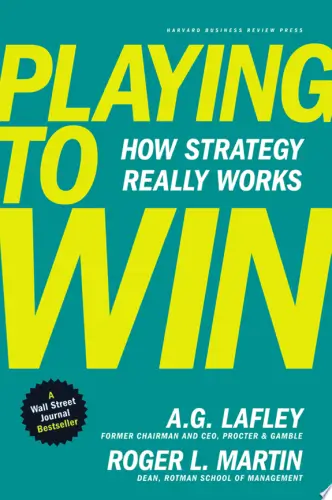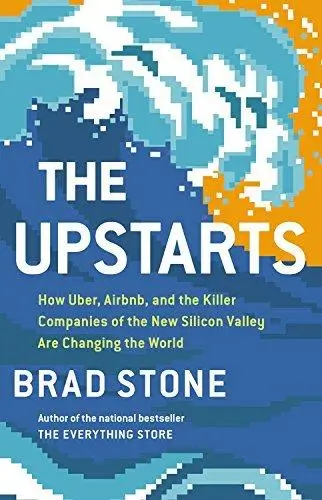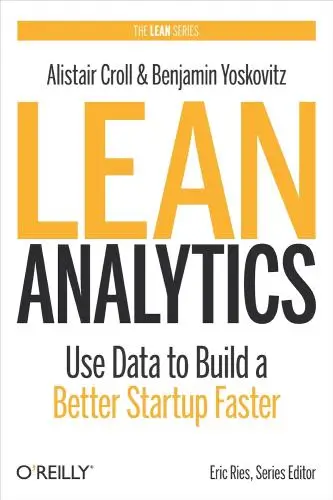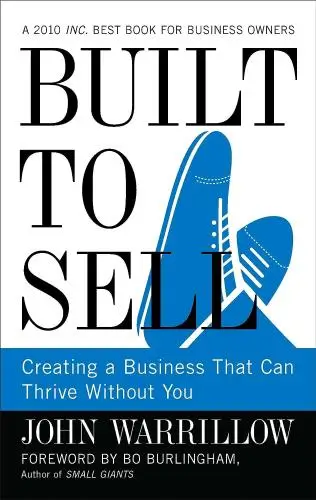
The Everything Store
Jeff Bezos and the Age of Amazon
What's it about?
The Everything Store offers an insider's perspective on Amazon's meteoric rise, chronicling its journey from a modest online bookstore to a global retail powerhouse. Stone delves into the brilliant, yet controversial leadership of Jeff Bezos, exploring his visionary approach and relentless pursuit of excellence. Packed with anecdotes and rigorous research, this book is a must-read for anyone curious about the innovation, strategy, and ambition driving one of the world’s most influential companies.
About the Author
Brad Stone is a master storyteller of the digital age, weaving intricate narratives around the titans and underdogs of the tech world. Best known for "The Everything Store: Jeff Bezos and the Age of Amazon" and "The Upstarts: Uber, Airbnb, and the Battle for the New Silicon Valley," his work dives deep into the ambitions and innovations that shaped our modern landscape. Stone's investigative rigor and vivid storytelling illuminate the human dramas behind the screens, making technology tales as compelling as any fiction.
10 Key Ideas of The Everything Store
Embrace Customer Obsession as Your Primary Focus
Prioritize customer satisfaction above all else, even if it means sacrificing short-term profits.
This approach involves deeply understanding customer needs and continuously innovating to meet and exceed those expectations.
The reasoning behind this tactic is that a highly satisfied customer base promotes loyalty, word-of-mouth recommendations, and repeat business, which are crucial for long-term success and growth.
Learn DeeperListen Actively to Your Customers: Make it a habit to seek out and pay attention to customer feedback. This can be through surveys, social media, or direct communication. Use this information to understand their needs and pain points.
Implement a Continuous Improvement Process: Regularly review your products, services, and customer interactions. Identify areas for improvement and make necessary adjustments. This could mean updating your product based on customer feedback or improving your customer service response time.
Foster a Customer-Centric Culture: Encourage everyone in your organization, regardless of their role, to think about how their actions affect the customer experience. Reward employees who go above and beyond to satisfy customers.
Innovate with the Customer in Mind: When developing new products or services, always consider how they will benefit the customer. Will it solve a problem for them? Make their life easier? Offer something they didn’t even know they needed?
Measure Success Through Customer Satisfaction: Instead of just focusing on sales or profit margins, use customer satisfaction metrics as a key indicator of your success. This could include net promoter scores (NPS), customer satisfaction scores (CSAT), or customer effort scores (CES).
- Example
Amazon’s practice of allowing customers to leave reviews and ratings for products, providing valuable feedback for both the company and other customers.
- Example
Zappos offering free returns and a 365-day return policy, emphasizing their commitment to customer satisfaction over immediate profits.
Implement a Culture of Frugality to Drive Innovation
Adopt a frugal mindset across the organization to encourage creative problem-solving and efficiency.
This means doing more with less, avoiding unnecessary expenditures, and focusing resources on what truly matters to customers.
The argument for frugality is that constraints can actually foster innovation by forcing teams to think outside the box and find cost-effective solutions that do not compromise on quality or customer experience.
Learn DeeperReview Your Expenses Regularly: Make it a habit to go through your monthly expenses, both personal and professional if applicable. Identify areas where you might be overspending or where you can cut back without sacrificing quality or productivity.
Embrace DIY Solutions: Before outsourcing tasks or purchasing new items, consider if there's a more cost-effective, do-it-yourself alternative. This could range from fixing minor issues yourself to creating your own marketing materials using free online tools.
Prioritize Needs Over Wants: When making purchasing decisions, ask yourself if the item or service is truly necessary. This helps in avoiding unnecessary expenditures and ensures that your resources are allocated to what's most important.
Leverage Free Resources and Tools: There's a wealth of free resources available online, from educational content to software tools. Before investing in paid solutions, see if there are free alternatives that can meet your needs effectively.
Encourage a Culture of Open Communication: Foster an environment where team members or family members feel comfortable sharing money-saving ideas. Sometimes, the best cost-cutting strategies come from collective brainstorming.
- Example
A small business owner reviews their subscription services and realizes they're paying for several overlapping tools. By consolidating their needs into one comprehensive tool, they save money without compromising on functionality.
- Example
A family decides to cut their entertainment expenses by canceling cable TV and instead subscribing to a more affordable streaming service that meets their viewing needs. They also allocate specific nights for board games or outdoor activities, which are low-cost but high in family bonding.
Make Data-Driven Decisions to Guide Strategy
Leverage data analytics to inform decision-making processes at every level of the organization.
This involves collecting, analyzing, and acting upon data related to customer behavior, market trends, and operational performance.
The rationale is that data provides objective insights that can help identify opportunities, optimize operations, and mitigate risks, leading to more informed and effective strategic choices.
Learn DeeperStart Small with Data Collection: Begin by identifying key areas of your life or work where data can help make better decisions. This could be as simple as tracking your daily expenses to understand spending habits or monitoring your exercise routine to see progress over time.
Use Tools to Analyze Data: Leverage free or low-cost data analysis tools available online. For personal finance, apps like Mint or YNAB can help analyze spending patterns. For fitness goals, apps like MyFitnessPal or Strava provide insights into workout effectiveness and health trends.
Set Clear Objectives for Data Use: Before diving into data collection and analysis, define what you're hoping to achieve. Whether it's saving a certain amount of money, improving health metrics, or increasing productivity at work, having clear goals will guide your data-driven decisions.
Regularly Review and Adjust Based on Data: Make it a habit to review the data you've collected on a regular basis. This could be weekly, monthly, or quarterly, depending on your goals. Use this time to adjust your strategies or behaviors based on what the data is telling you.
- Example
A small business owner tracks customer purchases and feedback through their point-of-sale system and online reviews. By analyzing this data, they identify that customers highly value quick service and unique product offerings. The owner then focuses on reducing wait times and sourcing exclusive products, leading to increased customer satisfaction and sales.
- Example
An individual looking to improve their physical health starts tracking their daily food intake and exercise routines using a health app. After a month of data collection, they notice that their energy levels and mood improve significantly on days with at least 30 minutes of exercise and a balanced diet. Motivated by these insights, they commit to a consistent exercise schedule and healthier eating habits.
Foster a Culture of High Standards and Continuous Improvement
Set exceptionally high standards for every aspect of the business and encourage continuous improvement to meet and surpass those standards.
This requires creating an environment where excellence is expected, feedback is actively sought, and employees are empowered to innovate and make improvements.
The idea is that by constantly raising the bar, the organization can achieve superior performance, product quality, and customer service.
Learn DeeperSet Clear, Achievable Goals: Start by defining what high standards mean for you or your team. Break down these standards into specific, measurable goals that everyone understands and can work towards.
Create a Feedback Loop: Implement regular check-ins or meetings where feedback is shared openly and constructively. Encourage everyone to contribute ideas on how to improve processes, products, or services.
Celebrate Improvements and Learn from Mistakes: When a goal is met or surpassed, take the time to celebrate the achievement. Similarly, when things don’t go as planned, use it as a learning opportunity rather than a failure.
Invest in Training and Development: Provide resources and opportunities for yourself and your team to gain new skills and knowledge. This could be through workshops, courses, or mentoring sessions.
Lead by Example: Demonstrate your commitment to high standards and continuous improvement in your own work. Your actions will inspire others to follow suit.
- Example
A restaurant manager sets a goal to reduce customer wait times. They implement a new seating system and train staff on efficient table management. After a month, they review the changes' impact, celebrating the reduced wait times and discussing further improvements.
- Example
A software development team aims to improve the quality of their code. They introduce code reviews and pair programming sessions. Each sprint, they reflect on the effectiveness of these practices and adjust their approach based on feedback from team members.
Adopt a Long-Term Perspective in Planning and Decision Making
Focus on long-term goals and sustainability rather than short-term gains.
This means making decisions that may not pay off immediately but will contribute to the company's enduring success and competitive advantage.
The reasoning is that a long-term perspective enables more substantial investments in innovation, talent, and infrastructure, which are essential for building a resilient and scalable business.
Learn DeeperSet Clear Long-Term Goals: Start by defining what success looks like for you or your business in the next 5, 10, or even 20 years. Consider where you want to be and what you want to achieve. This could range from financial stability, market leadership, innovation breakthroughs, or personal growth.
Evaluate Decisions with a Long-Term Lens: Before making any significant decision, ask yourself how it aligns with your long-term goals. Will this choice bring you closer to where you want to be in the future? If not, reconsider or adjust your approach.
Invest in Learning and Development: Allocate time and resources to learn new skills, technologies, or methodologies that may not benefit you immediately but will be invaluable in the long run. This could mean taking courses, attending workshops, or dedicating time to read and research.
Build Resilient Systems and Processes: Whether it's your personal life or your business, create systems and processes that can withstand challenges. This might involve diversifying income sources, creating emergency funds, or developing flexible business models that can adapt to change.
Practice Patience and Persistence: Understand that significant achievements take time. Cultivate patience and keep pushing forward, even when progress seems slow. Celebrate small wins along the way to stay motivated.
- Example
A tech startup decides to allocate a significant portion of its budget to research and development, focusing on a groundbreaking product that won't be market-ready for several years. They believe this product will revolutionize their industry and set them apart from competitors in the long run.
- Example
An individual chooses to pursue a part-time advanced degree while working full-time, understanding that the short-term sacrifice of time and comfort will significantly enhance their career prospects and earning potential in the future.
Deeper knowledge. Personal growth. Unlocked.
Unlock this book's key ideas and 15M+ more. Learn with quick, impactful summaries.
Read Full SummarySign up and read for free!
The Everything Store Summary: Common Questions
Experience Personalized Book Summaries, Today!
Discover a new way to gain knowledge, and save time.
Sign up for our 7-day trial now.
No Credit Card Needed

Similar Books

$100M Offers
Alex Hormozi
Principles of Marketing, Global Edition
Gary Armstrong
The 100 Best Business Books of All Time
Jack Covert
Playing to Win
A.G. Lafley
Productize
Eisha Armstrong
Start Your Own Pet-Sitting Business and More
Entrepreneur Press
The 22 Immutable Laws of Marketing
Al Ries
The Upstarts
Brad Stone
Lean Analytics
Alistair Croll
Built to Sell
John WarrillowTrending Summaries

Peak
Anders Ericsson
Never Split the Difference
Chris Voss
Smart Brevity
Jim VandeHei
The Psychology of Money
Morgan Housel
The First 90 Days
Michael D. Watkins
Atomic Habits
James Clear
Thinking, Fast and Slow
Daniel Kahneman
The Body Keeps the Score
Bessel van der Kolk M.D.
The Power of Regret
Daniel H. Pink
The Compound Effect
Darren HardyNew Books

The ^AOxford Handbook of Job Loss and Job Search
Ute-Christine Klehe PhD
Job Interviews For Dummies®
Joyce Lain Kennedy
Job Interviews In A Week
Alison Straw
Handbook of Career Development
Gideon Arulmani
The Art of Spending Money
Morgan Housel
$100M Offers
Alex Hormozi
A Candle for Kiri
Edna Mae Holm
Principles of Marketing, Global Edition
Gary Armstrong
Serpent Rising: The Kundalini Compendium
Neven Paar
